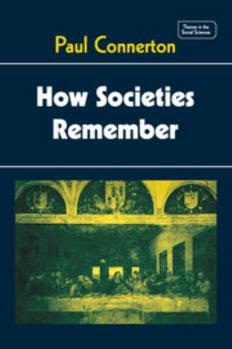How Societies Remember
(Part of the Themes in the Social Sciences Series)
Select Format
Select Condition 
Book Overview
In treating memory as a cultural rather than an individual faculty, this book provides an account of how bodily practices are transmitted in, and as, traditions. Most studies of memory as a cultural... This description may be from another edition of this product.
Format:Paperback
Language:English
ISBN:0521270936
ISBN13:9780521270939
Release Date:November 1989
Publisher:Cambridge University Press
Length:128 Pages
Weight:0.44 lbs.
Dimensions:0.4" x 5.9" x 8.9"
Customer Reviews
2 ratings
Communal ways of knowing
Published by Thriftbooks.com User , 21 years ago
Connerton's thesis about the communal/social aspects of memory prompted me to recall the proposed research project of a friend of mine in a doctoral programme, dealing with aspects of received knowledge of children - how do children of each successive generation, across social classes and often across cultural divides, seem to know certain things that are not taught to them by adults, particularly as adults seem to have forgotten these things themselves, but that are known by other children. How is this collective childhood body of knowledge maintained and continued without any formalised structure of preservation or transmission? This type of question can have relevance toward many types of study. Connerton's distinction between social memory and historical reconstruction is an important one. We might know the factual (or, at least, the conjectured factual) details of lost cultures and societies, but their social memory is, by virtue of their disappearance, inaccessible to us, save in the possible elements that have been continued in present cultures or societies. However, I am not sure I can subscribe to Connerton's complete application of the principle of historical reconstruction being necessarily removed from social memory. Connerton writes, `A historically tutored memory is opposed to an unreflective traditional memory.' (p. 16) We none of us operate as pure historical reconstructionists; our social memory influences even the manner in which we pursue an historical memory; surely there is a cross-influence as work as some level (and perhaps often different levels). Connerton works with distinctions: distinctions between myths and rites; distinctions between gestures referential and notational; distinctions between rites as symbolic, rites as quasi-textual, rites only in context; distinctions between literate and oral cultures and cultural aspects. However, it is in the blending of these elements that most of life is lived. For instance, Connerton states: `The impact of writing on social memory is much written about and evidently vast. The transition from an oral culture to a literate culture is a transition from incorporating practices to inscribing practices.' (p. 75) However, our culture is not an exclusively literate culture; it has not become a non-oral culture. Perhaps the most non-oral, literacy-dependent aspect of modern culture and information/learning transmission is the advent of the internet, yet even here, the trend even in the infancy of the internet is toward an incorporation of oral aspects - from examining aspects as formal as those internet teaching methods that are most effective to as simple an analysis of which websites are most popular, those which are text-only seem to be less effective and have less impact, whereas those which have `multi-media' elements (voice, music, etc.) are more effective. Still, one must not neglect the very different character of certain kinds of information. Particularly when examining the pas
Why does history repeat itself?
Published by Thriftbooks.com User , 21 years ago
Connerton believes that commemorative rituals create a form of "metaphysical present" where participants actually re-present the mythic events that contain meaning for them-they give it "ceremonially embodied form." There are three distinct types of memory (personal, cognitive, and habit-memory), all of which shape individuals and groups in social ways. The habit-memory is acquired in a similar way to language, and Connerton shows how the "meaning of a social habit rests upon others' conventional expectations such that it must be interpretable as a socially legitimate (or illegitimate) performance. Social habits are essentially legitimating performances. And if habit-memory is inherently performative, then social habit-memory must be distinctively social-performative." Social habit-memory is an "essential ingredient in the successful and convincing performance of codes and rules" (pp. 35-6). In a chapter on bodily practices, Connerton writes of the "choreography of authority," which is expressed through the body, where the specific postures, gestures, physical habit-memories, etc. used in performance of ritual provides a "mnemonics of the body" then provide codes for incorporating practices (much like inscribing practices, the study of which has been privileged in the West) (pp. 74-5). The implication, then, that we can "read" incorporated practices through their appropriate interpretation (much in the way that a hermeneutic scholarship has been able to interpret texts of law and theology, p. 96) as "techniques, proprieties, and ceremonies" seems like the development of a new theory that could potentially transform the study of ritual and performance in anthropology. An ability to "map" the habit-memory physicality of an event, in its historical and sociological context, could provide a way to speak about movement and action that-up to now-has not been accomplished.




